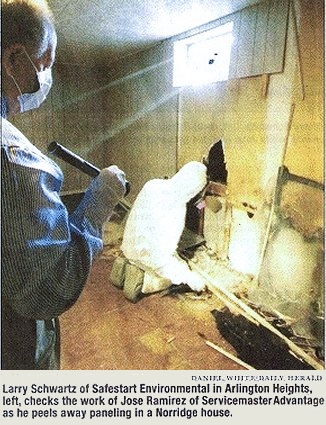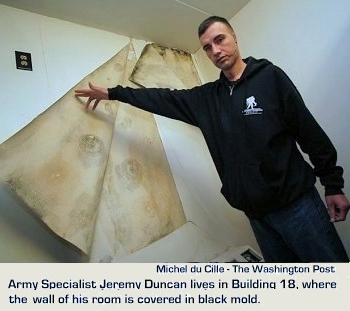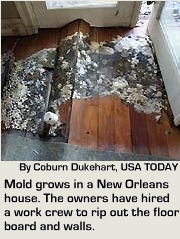|



National Certifying Body for Mold Professionals

|
 Get
Mold Certified Today Get
Mold Certified Today  My Account My Account 800-679-4381 800-679-4381 Enroll Enroll
PROFESSIONAL MOLD INSPECTION INSTITUTE
Mold Inspector / Mold Remediator Training and Certification
Does Mold Have A Hold?
 ©The Daily
Herald ©The Daily
Herald
Deborah Donovan
Any kind of water damage in a home has the potential for a growing problem. The good news is that homes for sale
in the suburbs rarely have the ugly, drippy kind of mold infestation seen in the news reports and homeowners nightmares.
The bad news is that any time water goes where it shouldn't in your house you will probably have mold unless it
is completeky dried out within 48 hours.
Getting rid of mold which can cause allergy-like symptoms in susceptible people -- require stopping the moisture
or improving the ventilation as well as removing or encapsulating the mold.
In addition to anywhere there's a leaky pipe or high humidity, such as a bathroom or kitch, prime areas for mold
include attics and basements, especially where paneling has been appied over drywall and carpet is on concrete.
While the really horrible health effects attributed to mold in Texasm Atlanta and Cleveland years ago have not
been proved, some experts believe there is a link, said Larry Schwartz, an Arlington heights-based industrial hygienist.
scwartz said any mold infestation in a house should be removed, no matter what type it is. For that reason, he
thinks in most cases there is no sense in doing air tests to find out the mold variety. He does test after the
remediation to be sure mold concentrations have been removed.
Torre Loftis knew she had a problem when mold was discovered in both attics of the Lake Zurich home she wanted
to buy. She and her husband, Paul, were recently married, and finding a home that the four teens in their blended
family all loved had not been easy.
The home inspector the Loftises hired discovered the mold after which they had Schwartz investigate the situation.
"Initially I was concerned," Torre Loftis said. "We have one kid with allergies and two with asthma.
But after studying the issue I was confident they could eliminate the problem," she said. "The air came
up normal afterwards, and I was reassured."
The remdiation included a treatment similar to sandblasting in the attics and adding ventilation that apparently
had been removed when storm damage was repaired, Loftis said.
"You could see the mold 5 feet up on the beams in the attic," she said, "It wasn't in the insulation
and it was reassuring that it hadn't gotten into the walls."
Schwartz was impressed that Loftis got so involved in researching the issue and checking thr removal process.
Mold grows on materials like drywall and wood. Generally, drywall, paneling, carpeting and ceiling tiles with mold
infestation are thrown away. More expensive structural materials like support beams are cleaned and treated.
Army Fixing Patients' Housing Changes Underway at Walter Reed
 ©The Washington
Post ©The Washington
Post
Dana Priest, Anne Hull
Walter Reed Army Medical Center began repairs yesterday on Building 18, a former hotel that is used to house outpatients
recuperating from injuries suffered in Iraq and Afghanistan and that has been plagued with mold, leaky plumbing
and a broken elevator.
The facility's commander, Maj. Gen. George W. Weightman, said Army staff members inspected each of the 54 rooms
at the building and discovered that outstanding repair orders for half the rooms had not been completed. He said
that mold removal had begun on several rooms and that holes in ceilings, stained carpets and leaking faucets were
being fixed.
Walter Reed, the Army's premier medical facility, has turned into a holding ground for wounded soldiers during
5 1/2 years of sustained combat. Almost 700 outpatients suffering from physical injuries and psychological problems
live on the 113-acre military post or in nearby quarters. Many linger there for 18 months or longer as they move
through the Army's numbing bureaucracy.
A Washington Post series over the weekend described "The Other Walter Reed," where overdoses, suicide
attempts and depression among outpatients are the parallel narrative to the spit-polish hallways of the renowned
hospital.
Building 18, in particular, symbolizes the indifference and neglect that many of the wounded say they experience
at Walter Reed.
Yesterday, Weightman said a broken elevator in the building had been repaired and soldiers were working to improve
the outside of the building, including removing ice and snow. The slippery conditions have kept some soldiers in
their rooms. A garage door that has been broken for months will soon be repaired as well.
Spec. Jeremy Duncan, whose room has a moldy wall that was featured in one photograph in the Post series, has been
moved to another room while workers make repairs. Duncan will be able to return to his room when the work is completed,
Weightman said.
Walter Reed and Army officials have been "meeting continuously for three days" since the articles began
appearing, Weightman said. A large roundtable meeting with Army and Defense Department officials will take place
at the Pentagon early this morning to continue talks about improvements in the outpatient system, he added.
Weightman said the medical center has received an outpouring of concern about conditions and procedures since the
articles appeared and has taken steps to improve what soldiers and their families describe as a messy battlefield
of bureaucratic problems and mistreatment.
"We're starting to attack how we'll fix and mitigate" some of the problems, he said.
Social workers will now be stationed around the clock at Mologne House, the 200-room hotel on the post where many
of the outpatients live. Plans are being developed to better train other staff members who deal with outpatient
needs.
The Army will also consider moving some outpatients to its other medical centers throughout the United States and
will determine over the next weeks whether more workers are needed at Walter Reed.
Mold Overtakes Flooded City in a Foul Flourish
 ©USA Today ©USA Today
Oren Dorell, Laura Parker, Tom Kenworthy
NEW ORLEANS. A throng of visitors has invaded the French Quarter, but they aren't tourists. They're mold spores,
and they're taking hold and growing furiously everywhere. On antiques in shuttered shops. On the white tablecloths
of empty cafes and restaurants. On the walls and furnishings of boutique hotels. On the green-spiked Cole Haan
high heels and alligator pumps in a Canal Street department store window.
At the Hotel Provincial on Rue Chartres, which advertises "the grace and charm of old world elegance,"
gray mold has invaded about 50 rooms. It is growing on the claw legs of anti-que tables and on the gilt frames
of mirrors and art prints.
"It's starting in the rooms that weren't even damaged now," said Scott Boswell, owner of Stella restaurant
across the courtyard from the hotel, as he led a tour.
More than three weeks after Hurricane Katrina flooded much of this city, residents and business owners face another
insidious calamity. Hot, humid New Orleans has become a giant mold factory.
"Mold is literally growing all over the city right now," said Carl Clayton, a New Orleans developer.
'No way to stop it'
Even homes spared from high water are at risk after three weeks with no air conditioning, Clayton said. And the
longer residents are barred from returning, the more their homes will decay.
"Some of these houses are going to have black mold growing up the walls and over the ceiling, and there's
no way to stop it," he said. "It will eat up the drywall and destroy it. ... At some point, even the
houses that could be saved will have to be torn down."
If residents and business owners in the Big Easy haven't
learned already, they will find that getting rid of the furry stuff eating away at their wallboard and furnishings
is labor-intensive, costly and sometimes a health threat.
"It's going to be a huge problem," said Martin King, a technical adviser to the Association of Specialists
in Cleaning and Restoration, a Maryland-based trade group for restoration contractors.
"Mold spores are everywhere," said Claudette Reichel, a professor and housing specialist at Louisiana
State University's AgCenter. "They are nature's recyclers. They break down materials like trees and plants
and organic matter."
Dave Keith, co-founder of K2 Environmental, a California company that specializes in repairing flood and mold damage,
said houses with serious mold problems essentially must be stripped down to the framing. Wallboard, linoleum and
insulation must be disposed of, along with furnishings such as
rugs, drapes and bedding ? almost everything that got wet or even damp.
Once a badly damaged house is stripped to the studs and other framing materials, the wood must be sanded and then
disinfected with a bleach solution to kill remaining spores. Then the house must be thoroughly dried with fans
or de-humidifiers. "It's basically rebuilding the house from the inside," Keith said.
Some efforts will fall short. Anu Dixit, an assistant professor at the Saint Louis University School of Public
Health, studied molds after Missouri River flooding. She found that mold returns in about one-third of affected
houses, even after treatments.
"People with allergies and asthma should not be involved in cleanup, and anyone whose immune system is compromised,"
Reichel warned. Some molds produce toxins that can cause serious health problems, including liver damage and cancer.
In New Orleans' Carrollton neighborhood, mold has climbed to shoulder height in the house where brothers Karry
and Felton Crowley grew up. The mold has formed felt-like blooms on clothing, furniture and nearly everything else
up to 5 feet off the floor.
"Anytime you have sewage back up into your house and then sitting there for days, you got bacteria and mold
growing all in there," said Karry Crowley, 48, who works in the engineering department for the New Orleans
Public Library.
'Tearing out'
Henry St. Amank, who owns Saint Construction in nearby Metairie, cleaned out a lawyer's office in the Mid-City
area, where the water left a mark 2 feet up the inside walls. St. Amank started four days ago, but the mold had
already traveled to 4 feet high.
St. Amank and his crew ripped out the carpet, baseboards, doors and trim and marked the lower 4 feet of drywall
for removal. They will soak the exposed framing with a mold-killing solution and allow it to dry before completing
the repairs, which will take six weeks and cost about $25,000.
At American Fashions Mens Wear, contractor George Hocutt of Decatur Holdings positioned a 4-foot fan in the doorway
and hauled out display cases and trash bags filled with soggy, mildewed merchandise. "I've been remodeling
houses for 20 years, and this is the worst I've ever seen," he said

30-Day Money-Back Guarantee

The only mold inspection and mold remediation training with a satisfaction guarantee!

©Professional Mold Inspection Institute (PMII). All rights reserved.
|